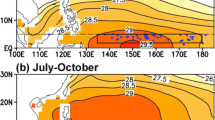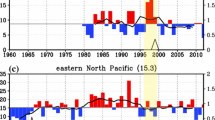Abstract
Five sets of model sensitivity experiments are conducted to investigate the influence of tropical cyclone (TC) genesis location and atmospheric circulation on interannual variability of TC intensity in the western North Pacific (WNP). In each experiment, bogus TCs are placed at different initial locations, and simulations are conducted with identical initial and boundary conditions. In the first three experiments, the specified atmospheric and SST conditions represent the mean conditions of El Niño, La Niña, and neutral years. The other two experiments are conducted with the specified atmospheric conditions of El Niño and La Niña years but with SSTs exchanged. The model results suggest that TCs generated in the southeastern WNP incurred more favorable environmental conditions for development than TCs generated elsewhere. The different TC intensities between El Niño and La Niña years are caused by difference in TC genesis location and low-level vorticity (VOR). VOR plays a significant role in the intensities of TCs with the same genesis locations between El Niño and La Niña years.
Similar content being viewed by others
References
Betts, A. K., 1986: A new convective adjustment scheme. Part I: Observational and theoretical basis. Quart. J. Roy. Meteor. Soc., 112, 677–692.
Betts, A. K., and M. J. Miller, 1986: A new convective adjustment scheme. Part II: Single column tests using GATE wave, BOMEX, ATEX and Arctic air-mass data sets. Quart. J. Roy. Meteor. Soc., 112, 693–709.
Betts, A. K., and M. J. Miller, 1993: The Betts-Miller scheme. The representation of cumulus convection in numerical models, K. A. Emanuel and D. J. Raymond, Eds., Amer. Meteor. Soc., 246pp.
Camargo, S. J., and A. H. Sobel, 2005: Western North Pacific tropical cyclone intensity and ENSO. J. Climate, 18, 2996–3006.
Camargo, S. J., K. A. Emanuel, and A. H. Sobel, 2007a: Use of genesis potential index to diagnose ENSO effects on tropical cyclone genesis. J. Climate, 20, 4819–4834.
Camargo, S. J., A.W. Robertson, S. J. Gaffney, P. Smyth, and M. Ghil, 2007b: Cluster analysis of typhoon tracks. Part II: Large-scale circulation and ENSO. J. Climate, 20, 3654–3676.
Chan, J. C. L., 1985: Tropical cyclone activity in the northwest Pacific in relation to the El Niño/southern oscillation phenomenon. Mon. Wea. Rev., 113, 599–606.
Chan, J. C. L., 2008: Decadal variations of intense typhoon occurrence in the western North Pacific. Proc. Roy. Soc. London, 464, 249–272.
Chan, J. C. L., and K. S. Liu, 2004: Global warming and western North Pacific typhoon activity from an observational perspective. J. Climate, 17, 4590–4602.
Chen, T. C., S. P. Weng, N. Yamazaki, and S. Kiehne, 1998: Interannual variation in the tropical cyclone Formation over the western North Pacific. Mon. Wea. Rev., 126, 1080–1090.
Chen, T. C., S. Y. Wang, and M. C. Yen, 2004: Role of the monsoon gyre in the interannual variation of tropical cyclone formation over the western north pacific. Wea. Forecasting, 19, 776–785.
Dudhia, J., 1989: Numerical study of convection observed during winter monsoon experiment using a mesoscale two-dimensional model. J. Atmos. Sci., 46, 3077–3101.
Frank, W. M., and E. A. Ritchie, 1999: Effects of environmental flow upon tropical cyclone structure. Mon. Wea. Rev., 127, 2044–2061.
Frank, W. M., and E. A. Ritchie, 2001: Effects of vertical wind shear on the intensity and structure of numerically simulated hurricanes. Mon. Wea. Rev., 129, 2249–2269.
Fudeyasu, H., Y. Wang, M. Satoh, T. Nasuno, H. Miura, and W. Yanase, 2010: Multiscale interactions in the life cycle of a tropical cyclone simulated in a global cloud-system-resolving model. Part I: Largescale and storm-scale evolutions. Mon. Wea. Rev., 138, 4285–4304.
Gray, W. M., 1968: Global view of the origin of tropical disturbances and storms. Mon. Wea. Rev., 96, 669–700.
Hong, S. Y., and H. L. Pan, 1996: Nonlocal boundary layer vertical diffusion in a medium-range forecast model. Mon. Wea. Rev., 124, 2322–2339.
Huang, P., C. Chou, and R. Huang, 2011: Seasonal modulation of tropical intraseasonal oscillations on tropical cyclone geneses in the western North Pacific. J. Climate, 24, 6339–6352.
Iizuka, S., and T. Matsuura, 2008: ENSO and western North Pacific tropical cyclone activity simulated in a CGCM. Climate Dyn., 30, 815–830.
Janjic, Z. I., 1994: The step-mountain eta coordinate model: Further development of the convection, viscous sublayer, and turbulent closure schemes. Mon. Wea. Rev., 122, 927–945.
Kalnay, E. M. Kanamitsu, and R. Kistler, 1996: The NCEP/NCAR 40-year reanalysis project. Bull. Amer. Meteor. Soc., 77, 437–471.
Kistler, R. E. Kalnay, and W. Collins, 2001: The NCEPNCAR 50-year reanalysis: Monthly means CD-ROM and documentation. Bull. Amer. Meteor. Soc., 82, 247–267.
Lander, M. A., 1993: Comments on “AGCM simulation of the relationship between tropical-storm formation and ENSO”. Mon. Wea. Rev., 121, 2137–2143.
Lander, M. A., 1994: An exploratory analysis of the relationship between tropical storm formation in the western North Pacific and ENSO. Mon. Wea. Rev., 122, 636–651.
Lau, K.-H., and N.-C. Lau, 1992: The energetics and propagation dynamics of tropical summertime synoptic-scale disturbances. Mon. Wea. Rev., 120, 2523–2539.
Liu, Y., D. L. Zhang, and M. K. Yau, 1997: A multiscale numerical study of hurricane Andrew (1992). Part I: Explicit simulation and verification. Mon. Wea. Rev., 125, 3073–3093.
Liu, Y., D. L. Zhang, and M. K. Yau, 1999: A multiscale numerical study of hurricane Andrew (1992). Part II: Kinematics and inner-core structures. Mon. Wea. Rev., 127, 2616–2597.
Lownam, S., and C. Davis, 2001: Development of a tropical cyclone bogussing scheme for the MM5 system. Preprint, the Eleventh PSU/NCAR Mesoscale Model Users’ Workshop, Boulder, Colorado, 130–134.
Matsuura, T., M. Yumoto, and S. Iizuka, 2003: A mechanism of interdecadal variability of tropical cyclone activity over the western North Pacific. Climate Dyn., 21, 105–117.
Pielke Jr., R. A., and C. N. Landsea, 1999: La Niña, El Niño, and Atlantic hurricane damages in the United States. Bull. Amer. Meteor. Soc., 80, 2027–2033.
Sobel, A. H., and E. D. Maloney, 2000: Effect of ENSO and MJO on the western North Pacific tropical cyclones. Geophys. Res. Lett., 27, 1739–1742.
Trenberth, K. E., 1997: The definition of El Niño. Bull. Amer. Meteor. Soc., 78, 2771–2777.
Wang, B., and J. C. L. Chan, 2002: How strong ENSO events affect tropical storm activity over the western North Pacific. J. Climate, 15, 1643–1658.
Wang, S. Y., and A. J. Clark, 2010: Quasi-decadal spectral peaks of tropical western Pacific SSTs as a precursor for tropical cyclone threat. Geophys. Res. Lett., 37, L21810, doi: 10.1029/2010GL044709.
Wong, M. L. M., and J. C. L. Chan, 2004: Tropical cyclone intensity in vertical wind shear. J. Atmos. Sci., 61, 1859–1876.
Wu, L., Z. P. Wen, R. H. Huang, and R. G. Wu, 2012: Possible linkage between the monsoon trough variability and the tropical cyclone activity over the western North Pacific. Mon. Wea. Rev., 140, 140–150.
Author information
Authors and Affiliations
Corresponding author
Rights and permissions
About this article
Cite this article
Zhou, Y., Jiang, J., Lu, Y. et al. Revealing the effects of the El Niño-southern oscillation on tropical cyclone intensity over the western north pacific from a model sensitivity study. Adv. Atmos. Sci. 30, 1117–1128 (2013). https://doi.org/10.1007/s00376-012-2109-5
Received:
Revised:
Accepted:
Published:
Issue Date:
DOI: https://doi.org/10.1007/s00376-012-2109-5




